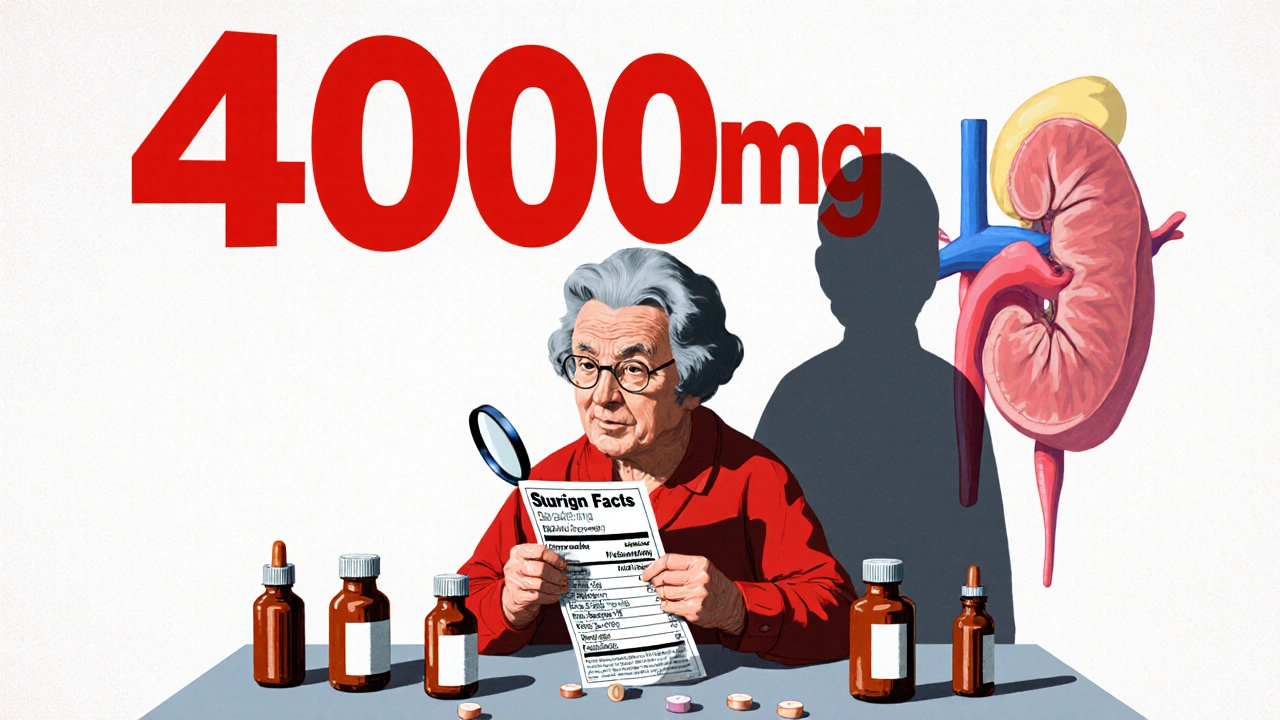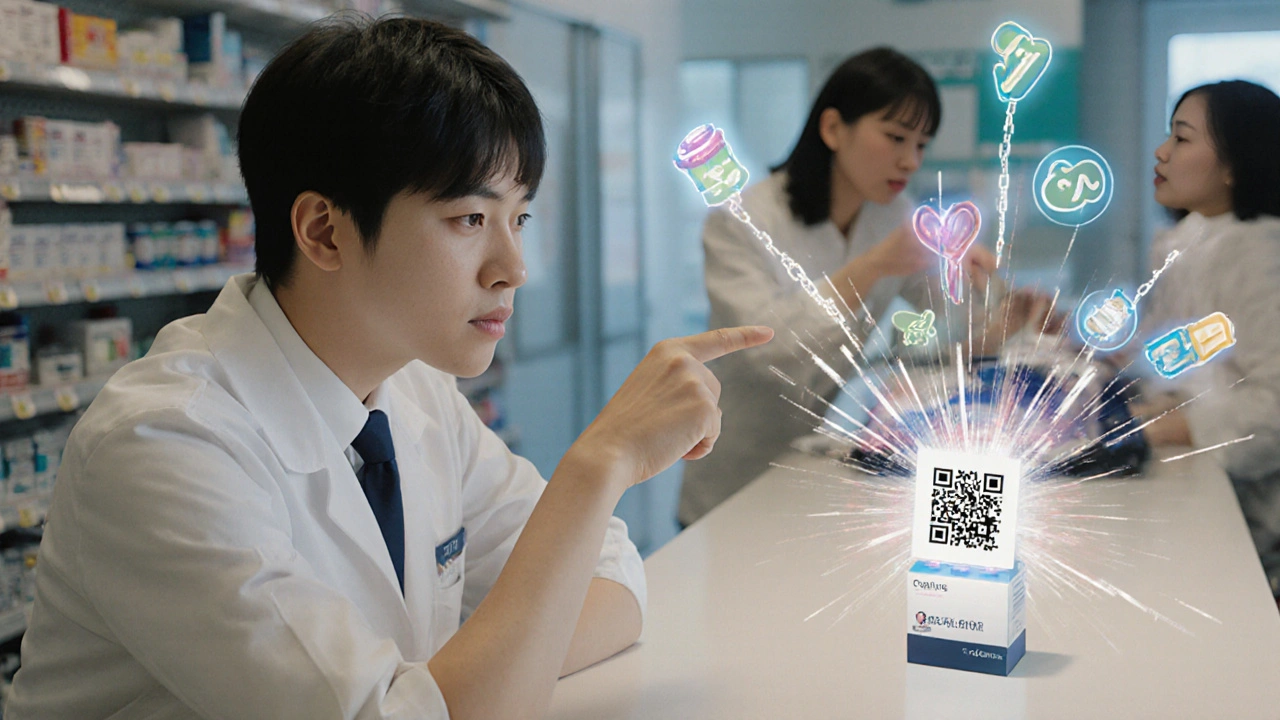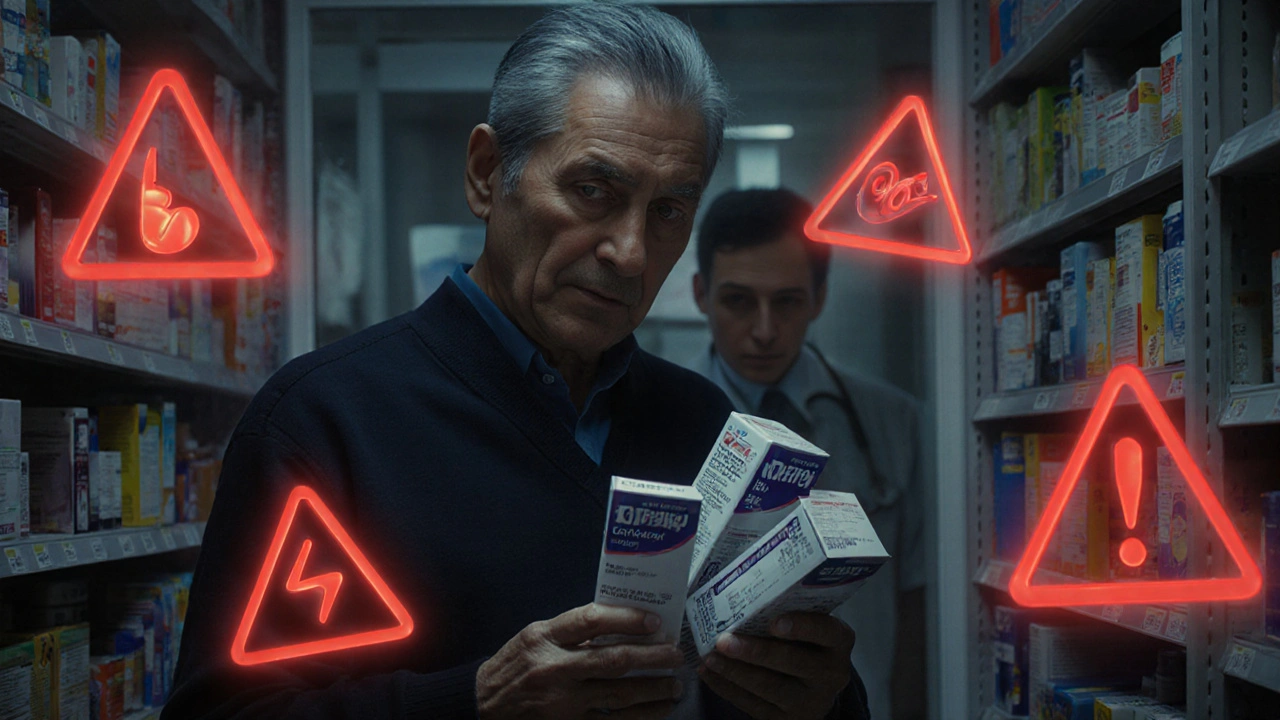OTC Medication Interaction Checker
Medication Safety Checker
Check for potential dangerous interactions between your OTC medications and prescription drugs. This tool is designed to help you identify common risks mentioned in the article.
When a medicine moves from prescription-only to over-the-counter (OTC), it seems like a win: you can grab it off the shelf without a doctor’s visit. But this shift isn’t just about convenience-it changes how you use the drug, and that can be risky if you don’t know what you’re doing.
What Happens When a Drug Goes OTC?
A prescription drug becomes OTC only after years of review by the FDA. The agency looks at whether people can safely self-diagnose the condition, understand the label, and avoid serious side effects without a doctor’s help. Ibuprofen was one of the first big switches in 1984. Before that, you needed a prescription. After the switch, prices dropped from $30-$40 a month to $5-$10. That’s a huge savings. But the real change wasn’t the cost-it was the access. Now anyone can buy it, anytime.
That’s the goal: more access, fewer doctor visits, lower healthcare costs. The Consumer Healthcare Products Association estimates Rx-to-OTC switches save the U.S. system about $102 billion a year. But here’s the catch: when you remove the doctor, you also remove the safety net.
The Hidden Risks of Self-Medication
People often think OTC means “harmless.” That’s dangerous. A 2023 study found that 77% of patients didn’t know the contraindications for common OTC drugs. Many didn’t even realize they were taking a medication-just a “pill for headaches.”
Take acetaminophen. It’s in more than 600 OTC products-pain relievers, cold medicines, sleep aids. If you take two different products at once, you could accidentally hit the toxic limit of 4,000 mg a day. That can cause liver failure. One Reddit user, PharmTech2020, shared how they saw patients double-dose because they didn’t know both their cold medicine and painkiller had acetaminophen.
NSAIDs like ibuprofen and naproxen are another concern. Used long-term, they can cause stomach ulcers, kidney damage, or even heart attacks. The risk jumps if you’re over 65, have high blood pressure, or take blood thinners. The American Geriatrics Society lists 30 OTC drugs that are especially risky for older adults. Diphenhydramine (Benadryl), for example, can cause confusion and falls in seniors.
Decongestants like pseudoephedrine can spike blood pressure. If you’re on certain antidepressants or heart meds, mixing them can lead to dangerous heart rhythms or strokes. One nurse on Reddit reported multiple cases of elderly patients developing severe hypertension after starting OTC nasal sprays-no one told them it could interact with their blood pressure pills.
Who’s Most at Risk?
Not everyone handles OTC drugs the same way. Certain groups need extra caution:
- Older adults: Their bodies process drugs slower. They’re also more likely to take multiple medications, increasing interaction risks.
- People with chronic conditions: Diabetes, kidney disease, liver problems, asthma, or heart disease can make OTC drugs more dangerous.
- Those on multiple prescriptions: Taking three or more meds? The chance of a harmful interaction goes up fast.
- Children: Dosing errors are common. What’s safe for an adult can be deadly for a kid.
Dr. Michael Ruffin, a family physician, says the biggest red flag is when someone says, “I just took a little extra because it wasn’t working.” That’s how overdoses start.

How to Use OTC Medicines Safely
You don’t need to avoid OTC drugs-just use them wisely. Follow these three steps every time:
- Read the Drug Facts label. It’s not filler. It’s your safety guide. Look at the “Warnings” section first. Does it say “Do not use if you have high blood pressure”? Then don’t use it.
- Check active ingredients. Write down every OTC and prescription drug you’re taking. Compare them. If two have the same active ingredient-like ibuprofen or acetaminophen-you’re doubling your dose.
- Ask your pharmacist. Pharmacists are trained to spot interactions. They can tell you if your cold medicine clashes with your blood pressure pill. A 2022 survey found 68% of people consult pharmacists before buying OTC drugs. But only 32% read the full label. Don’t be one of them.
The FDA requires all OTC labels to follow the “Drug Facts” format since 1999. That means you’ll see: active ingredients, purpose, uses, warnings, inactive ingredients, and directions. If the label looks outdated, unclear, or missing key info, put it back. Newer labels use bigger fonts and clearer language thanks to the FDA’s 2022 labeling update.
What About Digital Tools?
Some pharmacies are starting to use QR codes on OTC packaging. Scan it, and you get a video explaining side effects, or a link to a drug interaction checker. Walmart tested this in 15% of its private-label products in early 2023. It’s still early, but it could help people who struggle with reading or low health literacy-about 80 million adults in the U.S.
Future tools might use AI to suggest OTC options based on your medical history. But experts warn: tech won’t fix ignorance. If you don’t know your own meds or conditions, even the smartest app can’t protect you.

When to Call a Doctor
OTC drugs aren’t meant to replace medical care. If your symptoms last more than a few days-or get worse-you need to see someone. Don’t keep taking more pills hoping it’ll fix the problem.
Also, if you start feeling new symptoms after taking an OTC drug-dizziness, nausea, rash, chest pain, swelling-stop it immediately. That could be a reaction, not just a side effect.
Dr. David Kaelber says the biggest mistake people make is treating OTC drugs like candy. “They don’t realize they’re taking a medication,” he says. “And that’s when things go wrong.”
Final Thought: Knowledge Is Your Best Protection
OTC switches are a good thing-they save time, money, and reduce strain on the healthcare system. But they only work if you use them correctly. The risks aren’t theoretical. They’re happening every day in homes, pharmacies, and emergency rooms.
You don’t need to be a pharmacist to use OTC drugs safely. You just need to be careful. Know what you’re taking. Know what else you’re on. Know your limits. And when in doubt-ask. A pharmacist, a doctor, even a trusted friend. Better to pause than to risk your health.
Are OTC drugs safer than prescription drugs?
No, OTC drugs aren’t inherently safer-they’re just approved for use without a doctor’s supervision. That means they have a wider safety margin for the average person, but they still carry risks like liver damage, kidney injury, or dangerous interactions. Just because you can buy them without a prescription doesn’t mean they’re harmless.
Can I take OTC painkillers with my blood pressure medicine?
Some can, some can’t. NSAIDs like ibuprofen and naproxen can raise blood pressure and reduce the effectiveness of some blood pressure meds. Acetaminophen is usually safer for people with high blood pressure, but always check the label or ask your pharmacist. Never assume it’s safe-especially if you’re over 65 or have kidney issues.
Why do OTC labels say “do not use if you have high blood pressure”?
Many OTC cold and sinus remedies contain decongestants like pseudoephedrine or phenylephrine. These narrow blood vessels to reduce nasal swelling-but they also raise blood pressure. For someone with uncontrolled hypertension, that spike can trigger a stroke or heart attack. The warning is there because the risk is real and documented.
How do I know if I’m taking too much acetaminophen?
Check every product you’re taking-cold medicine, pain relievers, sleep aids. Look for “acetaminophen” or “APAP” on the label. The maximum safe daily dose is 4,000 mg. But if you have liver disease or drink alcohol regularly, your doctor may recommend no more than 2,000-3,000 mg. If you’re unsure, talk to your pharmacist.
Is it safe to give OTC medicine to my child?
Only if you use the right dose for their weight and age. Never use adult dosing for kids. Many OTC cold and cough medicines aren’t recommended for children under 6. Always check the label for age restrictions and use the measuring tool that comes with the product-not a kitchen spoon. If you’re unsure, call your pediatrician.
What should I do if I think I had a bad reaction to an OTC drug?
Stop taking the medicine immediately. If you have serious symptoms like trouble breathing, chest pain, swelling, or confusion, call emergency services. For milder reactions, contact your pharmacist or doctor. You can also report side effects directly to the FDA through their MedWatch program. Reporting helps improve safety for everyone.
Do pharmacists always check for drug interactions when I buy OTC meds?
Not always. A 2023 study in India found that while 85% of patients believed pharmacists gave them enough advice, only a small fraction were actually asked about their other medications or health conditions. Even in the U.S., many pharmacists are rushed. Don’t assume they’ll catch everything. Be your own advocate-tell them what you’re taking, even if you think it’s unimportant.


Andrew Forthmuller
November 13, 2025 AT 21:17OTC = easy to overdose. Seen it too many times.
Shante Ajadeen
November 14, 2025 AT 23:56My grandma takes 3 different OTC pills for sleep, pain, and ‘digestion’-and she swears none of them interact. She’s 78. I check her meds every Sunday. She doesn’t read labels. Neither do most people. Just saying.
Danae Miley
November 16, 2025 AT 12:33The FDA’s Drug Facts label is a masterpiece of consumer protection-but only if people actually read it. A 2022 JAMA study showed 72% of respondents couldn’t identify the active ingredient in their own OTC bottle. This isn’t negligence-it’s systemic failure. Labels aren’t the problem. Education is.
Elizabeth Buján
November 16, 2025 AT 14:35I used to think OTC meant ‘safe for everyone.’ Then my cousin took NyQuil and Advil together for a cold and ended up in the ER with liver enzymes through the roof. She didn’t even know both had acetaminophen. I cried for a week. We don’t need more warnings-we need people to care enough to ask before they pop something. It’s not just about reading labels. It’s about being human.
Erica Cruz
November 17, 2025 AT 06:02Oh wow, another ‘be careful with OTC meds’ article. Groundbreaking. The real issue? People are lazy. They don’t want to see a doctor because it’s ‘too much hassle.’ So they pop pills like candy and then blame Big Pharma when they get sick. Newsflash: you’re not a child. You have Google. Use it.
Charles Lewis
November 19, 2025 AT 05:03While the piece correctly highlights the risks associated with polypharmacy and self-medication, it fails to address the structural socioeconomic factors that drive consumers toward OTC alternatives in the first place. In communities with limited access to primary care, OTC medications are not a choice-they are a necessity. The burden of responsibility is unfairly placed on the individual, while systemic underfunding of public health infrastructure remains unchallenged. A true solution requires policy reform, not just behavioral nudges.
Arpita Shukla
November 19, 2025 AT 10:37Everyone’s panicking about acetaminophen but no one talks about how 80% of OTC cold meds in India contain hidden corticosteroids. You think you’re getting a simple decongestant? Nah. You’re getting a steroid that can wreck your adrenals if you use it for more than 5 days. And no, the label doesn’t say that. Because it’s not FDA-approved. But it’s everywhere. You think the US is safe? Think again.
Deepa Lakshminarasimhan
November 19, 2025 AT 20:09They say ‘read the label’ like it’s magic. But what if you’re blind? Or illiterate? Or don’t speak English? The FDA updates labels but doesn’t fix the system. QR codes? Cute. But my uncle in Delhi scanned one and got a link to a Walmart page in English. He cried. Who’s really being helped here?
Samantha Wade
November 21, 2025 AT 06:37Let me be clear: pharmacists are not your safety net. They’re overworked, underpaid, and often told not to spend more than 90 seconds per customer. Don’t wait for someone else to catch your mistake. Keep a written list of every medication you take-prescription, OTC, supplement, herb-and bring it to every visit. You are your own best advocate. No one else will do it for you.
Nicole M
November 22, 2025 AT 22:14My mom takes melatonin every night and thinks it’s ‘just a supplement.’ She also takes blood pressure meds. I asked her if she checked interactions. She said, ‘It’s natural, so it’s fine.’ I gave up. This isn’t about knowledge-it’s about denial.
dace yates
November 24, 2025 AT 14:42If OTC drugs are so safe, why does the FDA require a separate approval process for each switch? Why not just make everything OTC? There’s a reason they don’t. The line between ‘safe for self-use’ and ‘dangerous without oversight’ is thin. And we’re walking it blindfolded.
manish kumar
November 26, 2025 AT 11:09Look, I’m from India, and we’ve been doing this for decades. People buy antibiotics over the counter, take steroids for allergies, mix painkillers like candy. It’s chaos. But here’s the thing-when you have no access to doctors, you improvise. The problem isn’t the OTC switch-it’s the lack of healthcare infrastructure. We need clinics, not just better labels. You can’t educate your way out of poverty.
vanessa k
November 26, 2025 AT 17:11I used to be one of those people who took two Advil because one wasn’t enough. Then I had a stomach bleed. Took me months to recover. I didn’t know NSAIDs could do that. I’m not dumb. I just didn’t think it could happen to me. If you’re reading this and you’ve ever doubled up on OTC meds-stop. Talk to someone. You’re not alone.
Johnson Abraham
November 28, 2025 AT 14:59lol otc drugs r so dangerous?? 😂 next u’ll tell me water can kill u if u drink too much. i take ibuprofen every day. my back hurts. i dont need a dr to tell me that. stop scaremongering. #justtakeit
Renee Ruth
November 30, 2025 AT 01:48They’re coming for your painkillers next. Mark my words. First they make everything OTC, then they start restricting it. ‘Too many overdoses!’ ‘Too many interactions!’ Soon you’ll need a prescription for Tylenol. And then what? Will they make you sign a waiver before buying cough syrup? I’m not kidding. This is the first step. Watch.